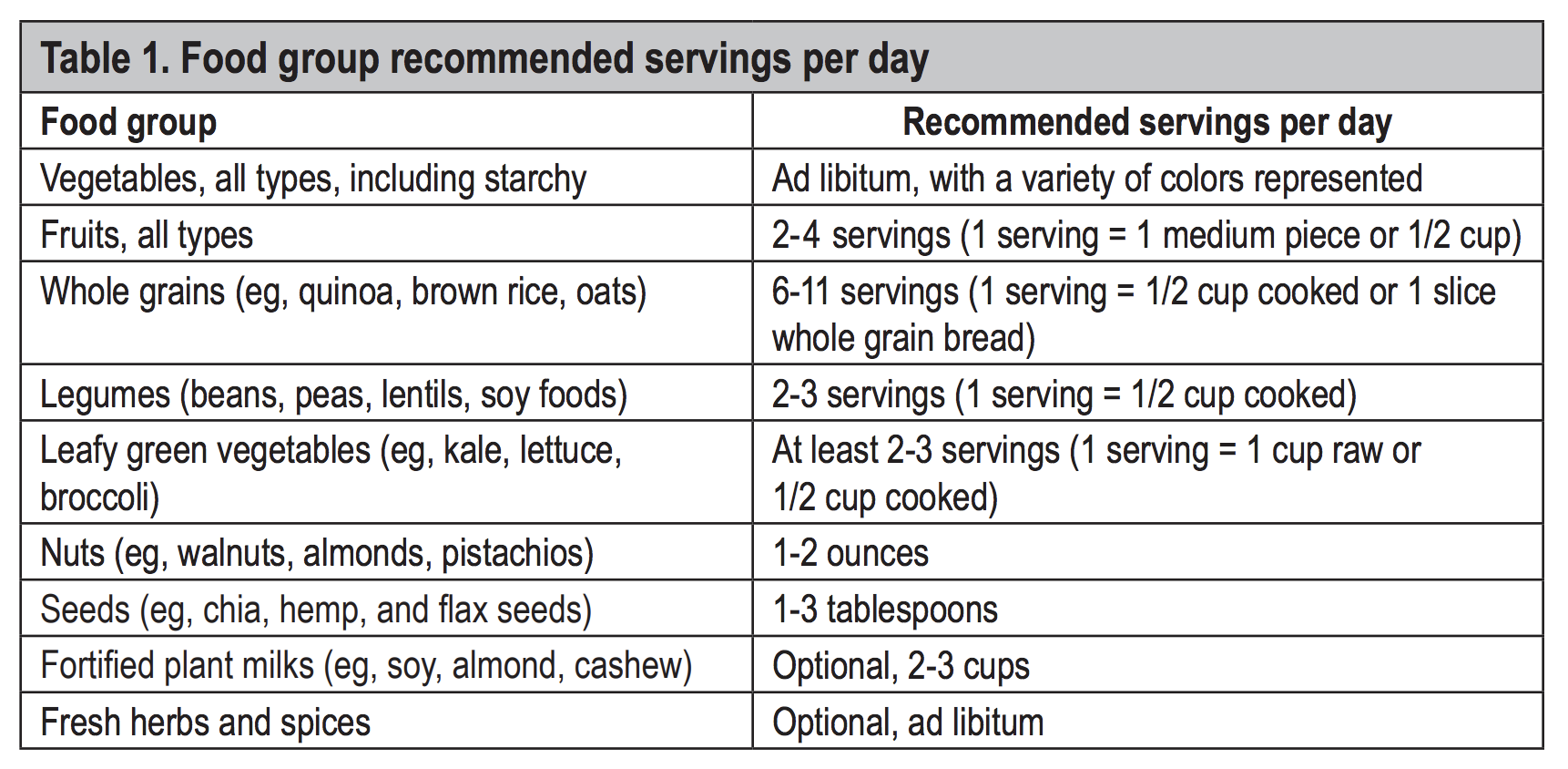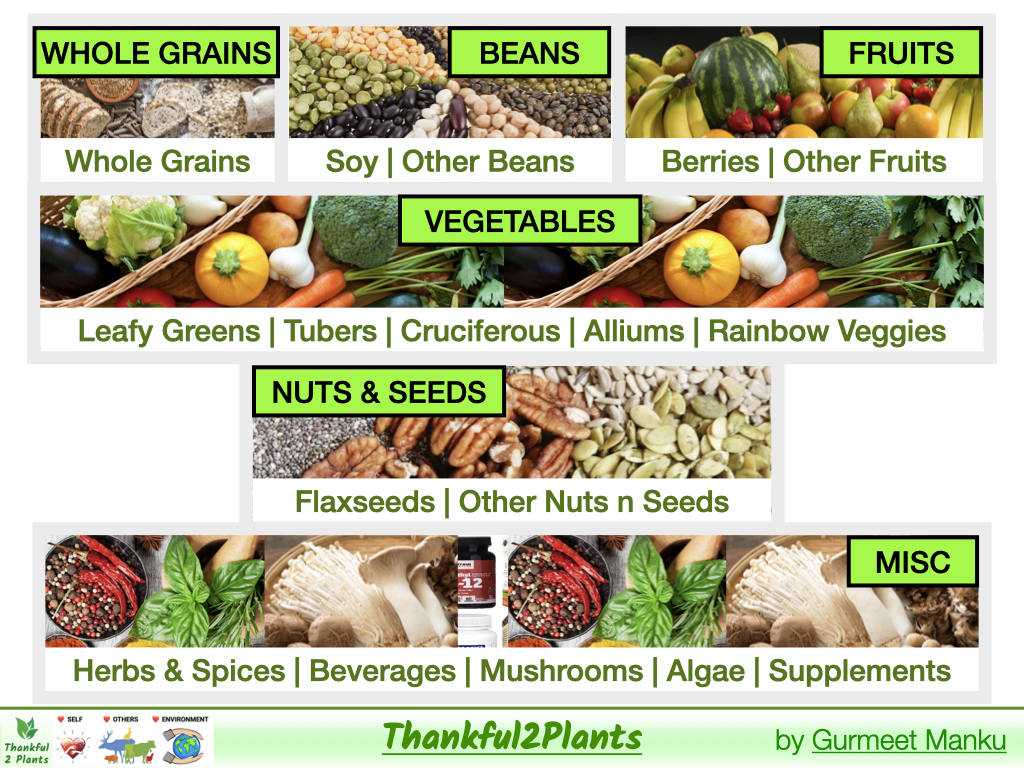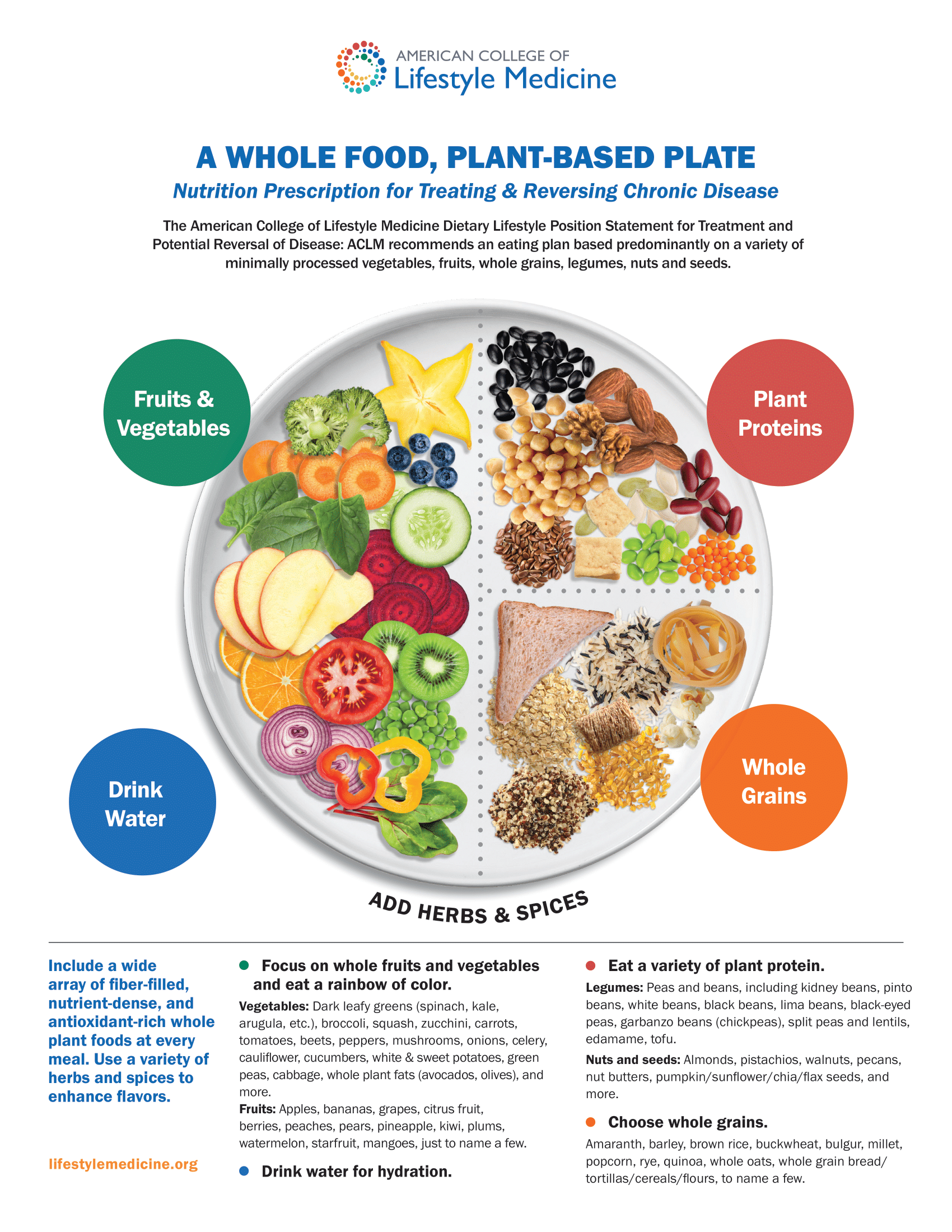Yes! We can simplify the above picture to only 6 food groups:(1) Whole Grains, (2) Beans, (3) Fruits, (4) Vegetables, (5) Nuts & Seeds, (6) Misc (Herbs & Spices, Beverages, …).
Often, there is a specific food in a food group that's so health promoting that we should consume that specific food and other foods from that food group.
1) WHOLE GRAINS: Whole Grains.
Even though we don't Whole Grains into sub-groups, this is actually the most complicated food group. Why? Because human beings are so creative! We have devised 20+ ways of eating whole grains. Which one is best? See Whole Grains.
2) BEANS: Soy Foods and Other Beans.
Soybeans are special! So we may divide Beans into two sub-groups: Soy Foods, and "Other Beans, Peas & Legumes". And yes, soy foods are actually healthy! WFPB doctors encourage us to eat around 1 to 2 servings every day.
3) FRUITS: Berries and Other Fruits
We may sub-divide Fruits into two sub-groups: Berries and Other Fruits. Why sub-divide? Because "Berries are the best Fruits!" — Dr Greger. But we shouldn't eat just berries. Other fruits are valuable too!
4) VEGGIES: Leafy Greens — Starch Rich Tubers — Cruciferous Veggies — The Allium Family — Rainbow-Colored Vegetables.
Diversity is important. Which ones to consume? We may sub-divide Vegetables into Starch Rich Tubers, Leafy Greens, Cruciferous, Alliums and Rainbow-Colored Veggies. Each one of these sub-groups has unique nutritional value. We must consume all of them. Also, within a sub-group, we should try to consume multiple different veggies.
5) NUTS & SEEDS: Flax Seeds, Nuts and Seeds. Also see Low Fat and No Oils!
Flaxseeds are so health promoting that we carve it out as a sub-group of its own. Also, avocados are fruits; peanuts are legumes. However, the 'Nuts & Seeds' includes both avocados and peanuts because they are fat rich.6) MISC: Herbs & Spices (Turmeric, Other Herbs & Spices), Beverages (Green Tea, Other Teas, Water), Mushrooms, Algae & Supplements (see Vitamin D — Vitamin B12 — DHA-EPA — Vitamins & Supplements?.
- The spice turmeric is so special that doctors like Dr Kristi Funk like to carve it out as a food group its own (so that we remember to consume it every day)!
- We may divide Beverages into Green Tea and Other Teas. Why? Green tea is one of the best teas around, with plenty of research highlighting its health benefits.
How to get started? Please don't let all these details of food groups and all these sub-groups overwhelm you. My suggestion is to start with Dr Neal Barnard's simple 4-component guidelines. They correspond to the food plate recommended by American College of Lifestyle Medicine:
For more details of ACLM's Food Plate, see Food Groups by American College of Lifestyle Medicine (ACLM).How to make progress? Week by week, month by month, we may pick up knowledge of different classes of veggies, fruits, seeds, and so on. And include somewhat esoteric food groups like mushrooms, green tea, seaweed, and so on.
A good target is to make food plates in harmony with Dr Greger's Daily Dozen. As the name suggests, the Daily Dozen is a 12-component food system. There's a free Daily Dozen app — it's great! We also have FaceBook support groups like this one.
After grasping Dr Greger's Daily Dozen, we can easily grasp Dr Kristi Funk's 14-component food system which is identical to Dr Greger's Daiy Dozen except that she has carved out specific foods which are known to be cancer protective. Examples: green tea, turmeric, mushrooms.
A request: Please get started with simple food plates, and keep learning & refining. Take it easy. It may as long as 3 to 6 months to really understood top notch nutrition guidelines and incorporate them into our daily food plates.
A summary of food groups outlined by different WFPB doctors:
2. Vegetables
3. Whole Grains
4. Legumes
Please study Food Groups by Dr Neal Barnard (PCRM).
2. Vegetables
3. Whole Grains
4. Legumes
5. Herbs & Spices
Please study Food Groups by ACLM.
2. Fruits
3. Whole Grains
4. Legumes
5. Nuts & Seeds
2. Vegetables
3. Tubers & Starchy Vegetables
4. Whole Grains
5. Legumes
2. Legumes
3. Greens
4. Roots
5. Other Veggies
6. Fruits
7. Omega-3 Rich Seeds
8. Spices
9. Beverages
2. Berries
3. Green Vegetables
4. Cruciferous Vegetables
5. Other Vegetables
6. Beans
7. Whole Grains
8. Flaxseed
9. Nuts
10. Spices
11. Beverages
12. Exercise (not a food component)
2. Leafy Greens
3. Other vegetables
4. Berries
5. Non-Berry Fruits
6. 100 percent Whole Grains
7. Beans / Legumes
8. Soy
9. Nuts / Seeds
10. Flaxseed
11. Turmeric
12. Spices
13. Water, Green Tea, Other Tea, Coffee
14. Supplements: B12, D, methylfolate, omega-3
2. Fruits
3. Vegetables
Dr Esselstyn is a former heart surgeon. His WFPB guidelines are pretty strict — targeted at heart patients. For details, please see

Source: Ornish Lifestyle Medicine. The four components in the logo are 'food', 'exercise', 'stress management' and 'love & support'.
Among WFPB luminaries, Dr Ornish seems to be the only one who emphasizes 'love & support' in a big way! See Food Groups Guidelines by Dr Dean Ornish.
2. Fruits
3. Beans & Legumes
4. Whole Grains & Potatoes
5. Seeds, Nuts & Avocados
6. Eggs, Oil, Fish, Wild / Naturally Raised Animal Products & Dairy (< 10% of calories)
7. Meats, Cheese, Sweets, Processed Foods (rarely)

Source: Plant-Based Diets: A Physician's Guide, Permanente J, 20(3):15-082 (Summer 2016).
Surprisingly, most of the websites fail to highlight supplements as an integral component of WFPB guidelines. The best general guidelines that I have come across for WFPB supplements are by Dr Greger: Optimum Nutrition Recommendations (2011; revised in 2016). Upon removal of animal products, we must take Vitamin B12 supplement. And if we don't spend enough time in the sun, we may need Vitamin D supplement. Dr Greger also recommends DHA-EPA.

 Instagram
Instagram YouTube
YouTube

